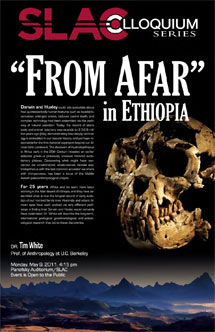

Tuesday - May 3, 2011
SLAC Today is
available online at:
http://today.slac.stanford.edu
In this issue:
Fermi Telescope Unites the Near and Far With Gamma Rays From the Sun
Special SLAC Colloquium May 9: "From Afar" in Ethiopia
Second of Two Power Outages at Building 50 This Weekend
 |
 |
|
Tuesday - May 3, 2011 |
Fermi Telescope Unites the Near and Far With Gamma Rays From the SunThe left panel shows the gamma rays observed by the Fermi LAT per pixel from near the sun; the right panel shows the same for another patch of sky. There is a clear large flux from the solar disk, and a less dense but extended flux surrounding it.
(Image courtesy the Fermi LAT team.)
In its revolutionary study of the gamma-ray sky, the Fermi Gamma-ray Space Telescope has thus far seen hundreds of distant active galaxies, and nearly 100 pulsars and binary objects in our galaxy, as well as the diffuse glow from particles accelerated in the aftermaths of supernovae. It has even brought the study of high-energy physics closer to home by capturing the gamma-ray output of a solar flare on the surface of the sun. Now the Fermi Telescope has brought together the astronomically near and far with observations of yet another celestial high-energy process. A recent analysis by the telescope team, led by Igor Moskalenko and Elena Orlando of the Kavli Institute for Particle Astrophysics and Cosmology at SLAC and Stanford, and Italian colleagues Monica Brigida and Nicolo Giglietto, combed through the first 18 months of observations of the sun from Fermi's Large Area Telescope, or LAT. The team found two distinct components of gamma-ray emission from the direction of the sun. One is coincident with the solar disk; the other extends outward, diminishing significantly by five degrees on the sky away from the sun—corresponding to roughly the distance from the sun to the orbit of Mercury—but not completely disappearing until 20 degrees away. Read more... Special SLAC Colloquium May 9: "From Afar" in Ethiopia See also the
event flyer (PDF, 300 KB). (Poster by SLAC Information Management and Portal Services.)
On May 9, 2011, the SLAC Colloquium committee is pleased to present a special talk by Professor of Anthropology at UC Berkeley Tim White, titled "From Afar," in which he will detail his team's decades of work in Ethiopia, unraveling the story of human evolution. Darwin and Huxley could only speculate about how quintessentially human features such as bipedal locomotion, enlarged brains, reduced canine teeth, and complex technology had been assembled via the pathway of natural selection. Today, the record of stone tools and animal butchery now extends to 2.5–2.6 million years ago (Ma), demonstrating how deeply technology is embedded in our natural history, and perhaps responsible for the first hominid expansion beyond our African birth continent. The discovery of Australopithecus in Africa early in the 20th Century revealed an earlier adaptive grade—a previously unknown hominid evolutionary plateau. Discovering what might have connected the small-brained, small-canined, bipedal Australopithecus with the last common ancestor we share with chimpanzees, has been a focus of the Middle Awash paleoanthropological project. For 25 years, White and his team have been working in the Afar desert of Ethiopia, and they have assembled what is now the longest record of early evolution of our hominid family tree. Hominids and extant African apes have each evolved via very different pathways, a finding that Darwin and Huxley would certainly have celebrated. Dr. White will describe the long-term, international geological, geochronological, and paleontological research that led to these discoveries. The talk will take place at 4:15 in Panofsky Auditorium, and is free and open to all. Second of Two Power Outages at Building 50 This WeekendThe second of two planned power outages will take place at Building 50 from 7 a.m. this Saturday until about 6 p.m. Sunday as the refurbished Substation 8 is brought online. Work began last month following the initial power outage, with the work on Substation 8 progressing smoothly and according to schedule, said John Weisskopf, Technical Operations Manager in charge of the project. "It's gone very well," Weisskopf said. He credits Boris Ilinets, the Facilities electrical engineer assigned full-time to SLAC Computing: "Boris is excellent. He does amazing work." According to Weisskopf, the outage will require interruptions to certain computing systems—the same systems that were affected during the previous outage, and for which Weisskopf worked closely with users of SLAC computing services to make sure it would be safe to temporarily shut these systems down. Vital computing services will not be affected. "Everything that was up last time will be up this time," Weisskopf said. |
EventsAccessAnnouncementsLab AnnouncementsCommunity Bulletin BoardTrainingLab Training
Upcoming Workshops & Classes
News |
|
| | ||
|
|
||
 <%
Response.AddHeader "Last-modified", getArticleDate()
'Response.AddHeader "Last-modified","Mon, 01 Sep 1997 01:03:33 GMT"
'Monday, December 06, 2010
%>
<%
Response.AddHeader "Last-modified", getArticleDate()
'Response.AddHeader "Last-modified","Mon, 01 Sep 1997 01:03:33 GMT"
'Monday, December 06, 2010
%>View online at http://today.slac.stanford.edu/. |
||